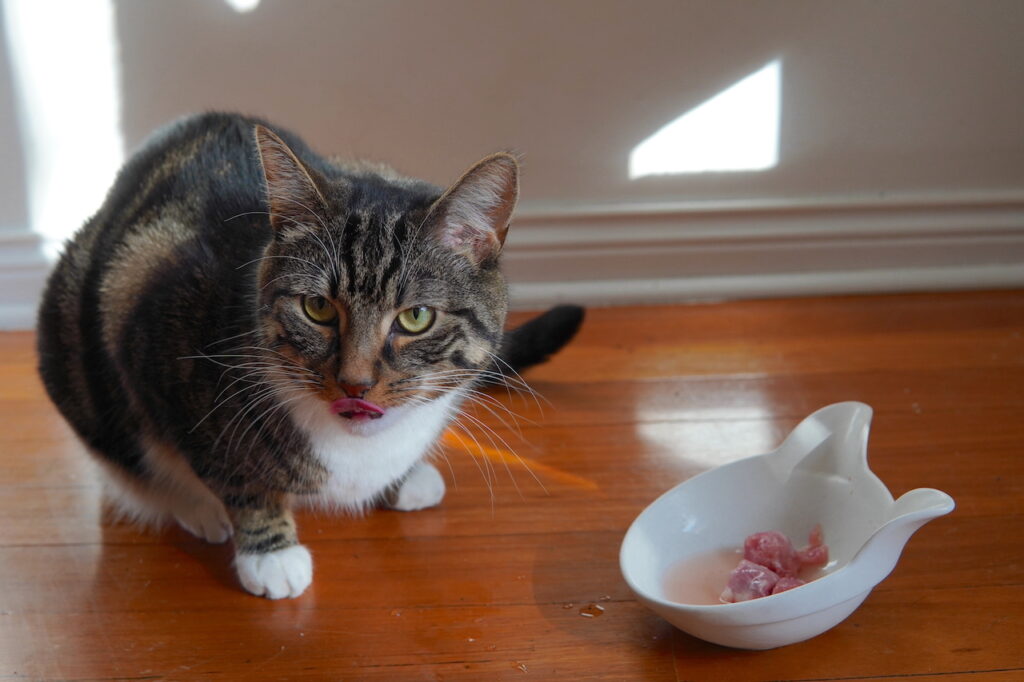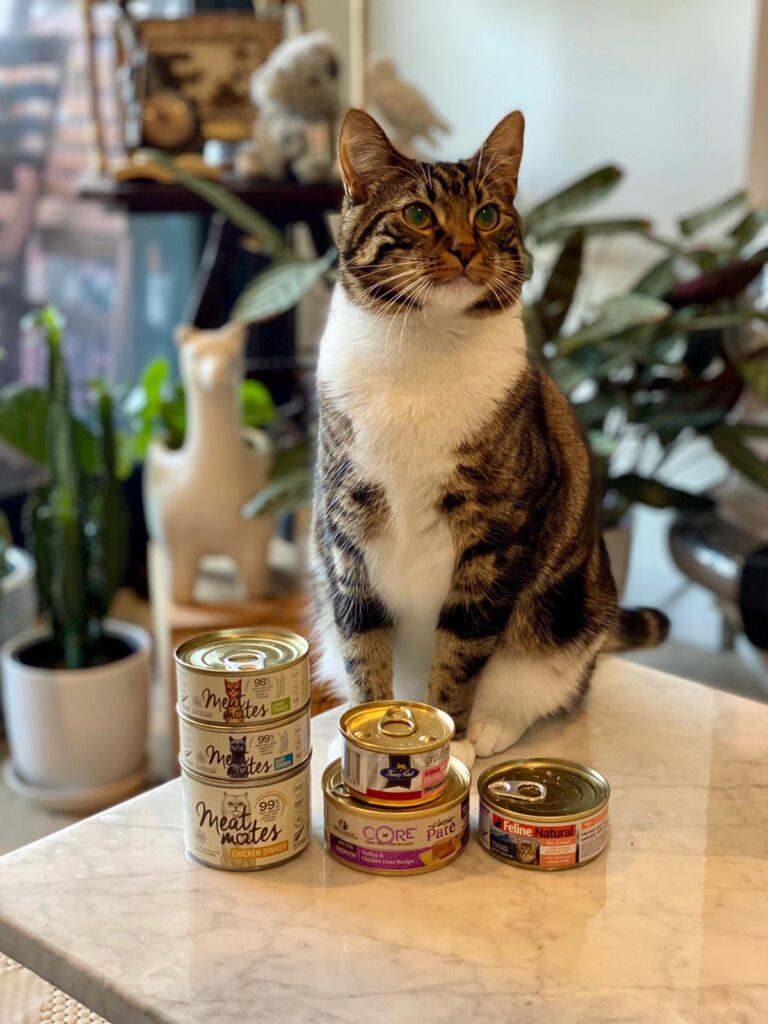Last Updated on March 25, 2024 by Indy the Cat
Did you know there is more to feeding a cat than simply putting down a bowl of food and having them devour it?
As passionate as we are about reviewing cat food, we are equally passionate about how to feed cats! Constructing a feeding routine is an important part of a cat’s routine and shouldn’t be taken lightly. Today, we’ll break down the ins and outs of everything you ever wanted to know about the feeding routine, from timing, frequency to getting the most out of one of their favourite pastimes.
1. What is the purpose of a feeding routine?
Let’s start at the top. What is the purpose of the feeding routine?
Stupid answer: to feed the cat so it doesn’t starve. Duh.
But no, the feeding routine is more than that to a cat. Eating is a basic need for all animals, but for cats it forms the backbone of their daily routine and how they interact with us.
What do we mean by that? The feeding routine itself helps build the 3 R’s (routine, ritual and rhythm as dubbed by the Catdaddy Jackson Galaxy) into the cat’s life. When a cat knows exactly what to expect and when to expect it, it gives them consistency and stability. With that, cats feel more confident and are happier in their environment.
So let’s dig more into what that looks like.
2. When should we feed our cats?
For many owners, it seems like their cats are always hungry. 30 minutes after a meal, it appears like they’re ready to eat again! What’s the solution?
Should I simply free feed most of the time?
No. we am highly against free feeding for the majority of cats. While convenient for us, free feeding sets up the expectation that food should be available for them at all times. This can lead to a number of issues including obesity, behaviour problems and poor energy balance for your cat.
Sound familiar? This is actually not too different to problems humans face when we have constant access to food. Free feeding is also predominantly done with dry food and this can be a problem in itself.
The general answer to this question really depends on your schedule. Build their mealtimes around you and what works for you. If you’re an early riser and don’t mind consistently feeding at 6am, then do that. Since the general rule is to not go longer than 12 hours between meals, your next mealtime is approximately 6pm. We feed Indy at 8am and 8pm because we don’t like to get up earlier than 8am on a weekend.
When you’ve set their meal times, be consistent and your patience will be rewarded with by a cat who becomes accustomed to your schedule.
If you’ve become customary to your cat meowing and howling you awake until you feed him/her at 6am, then the cat has trained you not the other way around! Staying stubborn to your routine creates the boundaries for the cat and when he/she gets to eat! It’s a win win for everyone.

3. But how often?
Okay, so we’ve established when we should feed our cats. Now, how often? Guess what the answer is.
It depends!
Most adult cats will thrive on two meals a day (one in the morning, one at night), but most are happy to eat more frequently (as you likely know.) The same rule applies, if you’re happy feeding three meals consistently, then feel free to go with that. While there may be small irregularities in feeding frequency, plan on sticking to the routine that you’ve set up.
If you’re feeding a kitten, you’ll be feeding as much as 5 meals a day in the early days. By four months, most cats can be on three meals a day and by six months, the majority of cats can shift to two meals a day.
If you do eventually change your feeding timing, you’ll need to go through another adjustment period for the cat to get used to the new schedule. Two meals is the sweet spot between meeting their needs and a frequency that works for most people’s schedules.
4. Where does water fit in?
If you’ve read Indy’s diet, you’ll know I’m a big advocate of adding water to your cat’s food. We still add water to all of his meals even though he’s on a primarily wet food diet. Hydration is such an important part of cats’ wellbeing that water fountains have become one of the most popular items for cat owners to purchase these days. If you don’t go that route, we recommend the simple habit of adding a bit of water to every meal.
If you’re starting out, you can begin with a small amount (1 tbsp), and increase it gradually to ensure the highest chance of success. If there’s no issues, you should have no issues eventually increasing it to 30-40mL for each meal. On top of a primarily wet food diet, this will ensure your cat(s) are getting plenty of water to flush through their systems. With increased water intake, you’ll see other awesome benefits such as a decrease in urine smell in their litter box. Another win for everyone!
5. Playtime = Mealtime
Do you play with your cat?
We hope so! Playing with your cat is an important part of building and maintaining the bond with your cat(s). In addition, the activity provides them with exercise, stimulation and a chance to hunt. Essentially, playtime is hunting time!
So what am we trying to get at? Well, cats are heavily motivated by their primal instincts. The cycle of hunt, catch, kill, forms a key part of their genetic makeup and tapping into this behaviour is a nice and natural way to build a routine for a cat. Indy is a single cat, so he doesn’t get a chance to play and wrestle with other cats. This makes playtime even more important for him as he gets to burn off pent up energy.
Before each meal, we play with him giving him something to hunt and chase. Eventually, we leave the toy with him or nearby so he can “kill” his prey. Sometimes he does, sometimes he doesn’t. Right after playtime is mealtime. He might not be eating that toy butterfly, but it certainly taps into that part of his instincts.
Building a routine where you feed your cat following a playtime session can really help your cat find their rhythm. While you don’t have to have a perfect routine around it, like everything we’ve already mentioned, consistency will help your cat feel happy and confident.
Finding the Purrfect Routine
If you’ve never given your cat’s feeding routine much thought, now’s a chance to change that!
We hope that this article has opened your eyes and it won’t be long before you’re well on your way to mastering your cat’s feeding routine. If you have any questions or comments, feel free to get in touch!
If you spot an error in this article, please do not hesitate to let us know!



Pingback: How to Feed Kittens – 5 Best Feeding Tips for Kitten -